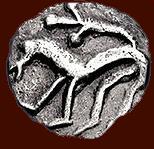








Designed by Nigel G Wilcox






The Paragon Of Metal Detecting
& Archaeology
& Archaeology
Powered By Sispro1
Anglo-Saxon & Viking A.D. - Currency Numismatics,
Mancus
For Reference ONLY
Everything For The Detectorist
Mancus
Copyright All Rights Reserved by Nigel G Wilcox E-Mail: ngwilcox100@gmail.com
Viking Menu
Viking Timeline
Anglo-Saxon Timeline
| 1. Estimated value 2014 : 230,000 - 357,832 |
1.
 -805-810AD.jpg)
Made from more than 85 per cent gold, weighing 4.33g, 19mm and showing almost no sign of wear, the coin was struck in 805-810 during the reign of Coenwulf, the King of Mercia, East Anglia and Kent, the most powerful ruler in Britain at the time and a significant figure in the gradual unification of England.
A mancus has a nominal value of 30 silver pennies. The design on the obverse is derived from a late Roman imperial bust. The floral design on the reverse is unique in coinage of this period and there is an intriguing inscription, DE VICO LVNDONIAE meaning from the trading place of London.
Little is known about Anglo-Saxon coinage - and less still about Coenwulf who ruled Mercia from 796 to 821.
Coenwulf was, like rulers before and after him, in thrall to the language and culture of the Romans who had left Britain three centuries earlier. His decision to use the word vicus, meaning a trading centre, on the coin rather than civitas, the city seat of authority, is a strong indication that the coin was for trading.
The mancus was found several inches below a footpath on the bank of the Ivel near Biggleswade in 2001 by a metal detector enthusiast
A mancus has a nominal value of 30 silver pennies. The design on the obverse is derived from a late Roman imperial bust. The floral design on the reverse is unique in coinage of this period and there is an intriguing inscription, DE VICO LVNDONIAE meaning from the trading place of London.
Little is known about Anglo-Saxon coinage - and less still about Coenwulf who ruled Mercia from 796 to 821.
Coenwulf was, like rulers before and after him, in thrall to the language and culture of the Romans who had left Britain three centuries earlier. His decision to use the word vicus, meaning a trading centre, on the coin rather than civitas, the city seat of authority, is a strong indication that the coin was for trading.
The mancus was found several inches below a footpath on the bank of the Ivel near Biggleswade in 2001 by a metal detector enthusiast
Coenwulf 796-821 AD
Coenwulf-796-821AD
Pages
Main Coin Menu
Anglo-Saxon
Menu
Menu
Member NCMD
A.S. Menu
Information Data
























